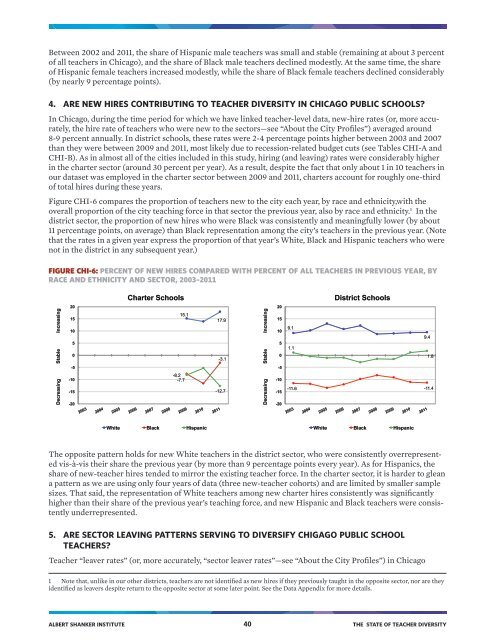TEACHER DIVERSITY
The State of Teacher Diversity_0
The State of Teacher Diversity_0
- No tags were found...
Create successful ePaper yourself
Turn your PDF publications into a flip-book with our unique Google optimized e-Paper software.
Between 2002 and 2011, the share of Hispanic male teachers was small and stable (remaining at about 3 percent<br />
of all teachers in Chicago), and the share of Black male teachers declined modestly. At the same time, the share<br />
of Hispanic female teachers increased modestly, while the share of Black female teachers declined considerably<br />
(by nearly 9 percentage points).<br />
4. ARE NEW HIRES CONTRIBUTING TO <strong>TEACHER</strong> <strong>DIVERSITY</strong> IN CHICAGO PUBLIC SCHOOLS?<br />
In Chicago, during the time period for which we have linked teacher-level data, new-hire rates (or, more accurately,<br />
the hire rate of teachers who were new to the sectors—see “About the City Profiles”) averaged around<br />
8-9 percent annually. In district schools, these rates were 2-4 percentage points higher between 2003 and 2007<br />
than they were between 2009 and 2011, most likely due to recession-related budget cuts (see Tables CHI-A and<br />
CHI-B). As in almost all of the cities included in this study, hiring (and leaving) rates were considerably higher<br />
in the charter sector (around 30 percent per year). As a result, despite the fact that only about 1 in 10 teachers in<br />
our dataset was employed in the charter sector between 2009 and 2011, charters account for roughly one-third<br />
of total hires during these years.<br />
Figure CHI-6 compares the proportion of teachers new to the city each year, by race and ethnicity,with the<br />
overall proportion of the city teaching force in that sector the previous year, also by race and ethnicity. 1 In the<br />
district sector, the proportion of new hires who were Black was consistently and meaningfully lower (by about<br />
11 percentage points, on average) than Black representation among the city’s teachers in the previous year. (Note<br />
that the rates in a given year express the proportion of that year’s White, Black and Hispanic teachers who were<br />
not in the district in any subsequent year.)<br />
FIGURE CHI-6: PERCENT OF NEW HIRES COMPARED WITH PERCENT OF ALL <strong>TEACHER</strong>S IN PREVIOUS YEAR, BY<br />
RACE AND ETHNICITY AND SECTOR, 2003–2011<br />
Charter Schools<br />
District Schools<br />
Decreasing Stable Increasing<br />
20<br />
15<br />
10<br />
5<br />
0<br />
-5<br />
-10<br />
-15<br />
-20<br />
15.1<br />
-8.2<br />
-7.7<br />
17.9<br />
-3.1<br />
-12.7<br />
Decreasing Stable Increasing<br />
20<br />
15<br />
10<br />
5<br />
0<br />
-5<br />
-10<br />
-15<br />
-20<br />
9.1<br />
9.4<br />
1.1<br />
1.8<br />
-11.6 -11.4<br />
White Black Hispanic<br />
White Black Hispanic<br />
The opposite pattern holds for new White teachers in the district sector, who were consistently overrepresented<br />
vis-à-vis their share the previous year (by more than 9 percentage points every year). As for Hispanics, the<br />
share of new-teacher hires tended to mirror the existing teacher force. In the charter sector, it is harder to glean<br />
a pattern as we are using only four years of data (three new-teacher cohorts) and are limited by smaller sample<br />
sizes. That said, the representation of White teachers among new charter hires consistently was significantly<br />
higher than their share of the previous year’s teaching force, and new Hispanic and Black teachers were consistently<br />
underrepresented.<br />
5. ARE SECTOR LEAVING PATTERNS SERVING TO DIVERSIFY CHIGAGO PUBLIC SCHOOL<br />
<strong>TEACHER</strong>S?<br />
Teacher “leaver rates” (or, more accurately, “sector leaver rates”—see “About the City Profiles”) in Chicago<br />
1 Note that, unlike in our other districts, teachers are not identified as new hires if they previously taught in the opposite sector, nor are they<br />
identified as leavers despite return to the opposite sector at some later point. See the Data Appendix for more details.<br />
ALBERT SHANKER INSTITUTE 40 THE STATE OF <strong>TEACHER</strong> <strong>DIVERSITY</strong>


